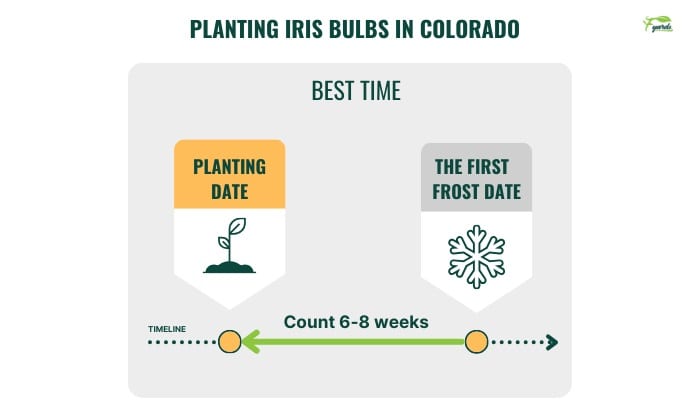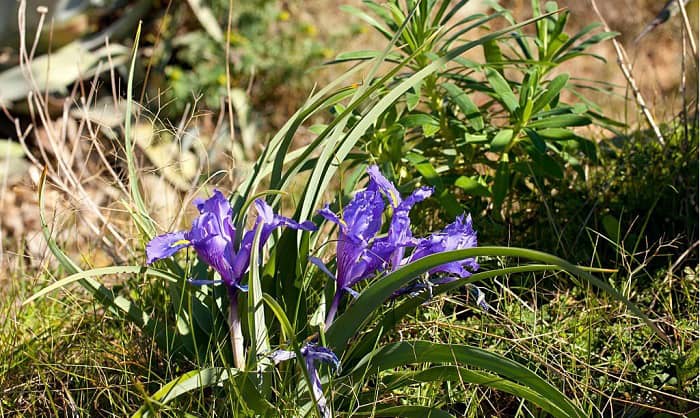Irises are known as one of the best, most fragrant, and hardiest flowers to grow in Colorado. Like its namesake, the Greek goddess of the rainbow, irises come in many colors and are favored by many flower and garden lovers.
Planting iris bulbs in late summer through autumn, between July and September, offers wonderful growing conditions.
Discover more tips on when to plant iris bulbs in Colorado and ways to ensure healthy and scented flowers throughout the spring season.
Table of Contents
Best Time to Plant Iris Bulbs in Colorado
1. Plant around July through September
The best time to plant iris bulbs in Colorado depends on the location you’re in. Iris bulbs can be sown in the late summer or in fall, typically, from late July through September.
This time frame allows the bulbs to take root and absorb moisture before winter cold sets in, which will help them bloom once the temperature rises again in the spring.
Bearded varieties, one of the most common iris types, are often planted in late summer to early fall. Siberian irises can also be grown in the same time frame, while Dutch varieties can only be planted in autumn.
2. Plant 6-8 weeks before the first frost date
Colorado lies in hardiness zones 3 to 7. And it has a diverse climate, ranging from high mountains to semi-arid plains.
Therefore, it’s essential to know your location within USDA zones to determine the best time to plant your iris bulbs, since the first frost dates vary across locations.
Zone 3’s average first frost is September 8th, for example, making July 28th a suitable planting date.
Meanwhile, zone 7’s average first frost of October 29th means September 17th is excellent for growing irises.
- Plant according to your first frost date.
Ideally, you’d want to plant your bulbs as early as possible in the fall. The timeframe could be six to eight weeks before the first frost date.
Therefore, if you live in Colorado Springs, you can plant them around August 8th to 22nd, based on the region’s first frost on October 3rd. During this time, ample watering is sufficient to encourage proper root growth.
| Location | Last Frost Date | First Frost Date |
| Colorado Springs | May 8 | October 3 |
| Denver | May 4 | October 6 |
| Fort Collins | May 7 | October 2 |
| Littleton | May 8 | October 5 |
| Longmont | May 13 | October 1 |
| Parker | May 14 | September 28 |
- Plant in well-draining soil
Aside from the dates, soil condition is crucial in planting to ensure your iris varieties will thrive in your area. The dominant soil type in Colorado is heavy clay.
While iris bulbs are relatively easy to plant and nurture, the tight-layered Colorado soil presents a challenge for beginner gardeners. However, simple adjustments can be made to make your soil more suitable and hospitable for your iris plants.
Irises thrive in well-draining soil. So, whether you’re planting irises in pots or directly in the ground, it’s crucial to prepare the soil by adding organic matter like compost to encourage proper drainage.
Tips for Successful Iris Bulb Cultivation in Colorado
- Prepare your planting area
Remove unwanted grass to create a clean and clear space for your irises. Digging holes with proper spacing is essential, and they should be 4 inches deep and 12-18 inches apart, depending on the iris variety.
Adequate spacing promotes air circulation, preventing overcrowding.
- Apply mulch around the iris plant
For those looking to start a Colorado iris farm, fall is the ideal season to plant iris rhizomes and bulbs. But, ensure to mulch your iris plants to help keep soil moisture and prevent weeds from emerging.
Remember to water the plants adequately (an inch of moisture per week), and avoid over-watering as it can lead to diseases.
- Plant in full sun or partial shade based on your iris variety.
Generally, irises thrive in full sunlight, but some variants, like the crested irises, prefer some shade.
For the crested variants, you may transplant them into well-draining pots and take them inside your house.
- Apply fertilizer
Fertilizers would encourage faster root establishment and strong, steady growth for iris bulbs. So, feed them immediately after planting while following the instructions on the all-purpose fertilizer you chose.
- Divide iris bulbs after the blooming season
Irises become overcrowded every three to four years. The solution is to divide irises once they’ve stopped blooming.
Trim the foliage down to six inches, then carefully dig up the iris clumps. Divide the rhizomes accordingly and discard the original bulb. Afterwards, transplant iris plants to encourage new and vigorous growth.
Conclusion
Whether you’re considering starting an iris farm or simply want to enjoy the beauty of these elegant flowers in your garden, following this iris planting guide will help you achieve success.
Remember to choose the right time, provide suitable growing conditions, and consider dividing and transplanting iris as they mature.
With proper care and attention, your iris plants will thrive and bring vibrant colors and scents to your yard every spring. Hopefully, you learned a lot about when to plant iris bulbs in Colorado. Happy iris planting!

Hi, I am William – Floridayards’ digital content creator. My job is to find answers to all your concerns with thorough research and our team’s expert advice. I will also bring you honest reviews on the best products and equipment for raising your beautiful garden. Please look forward to our work!













